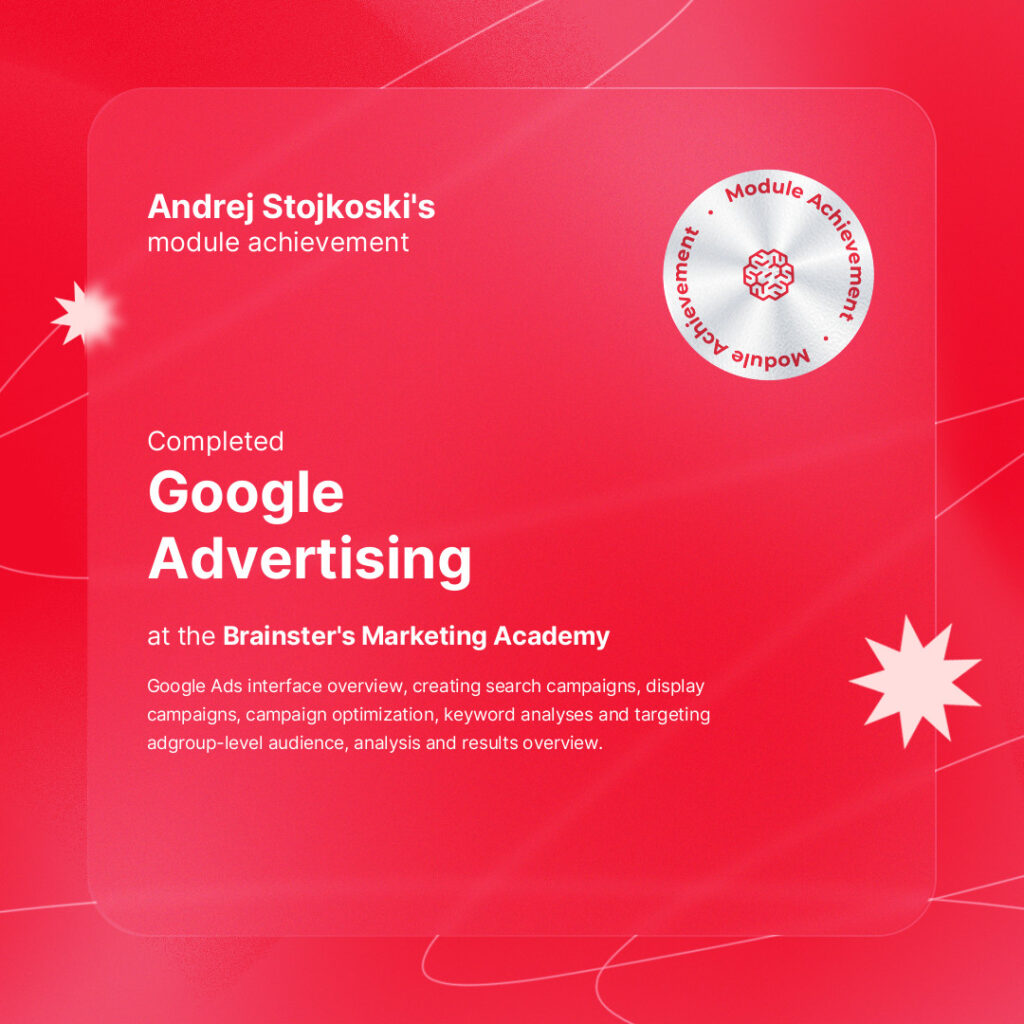From Organic to Paid: Stepping into Google Advertising After SEO
After mastering Search Engine Optimization (SEO) and learning how to organically boost visibility, it was time to explore the paid side of digital marketing—Google Advertising.
This module at Brainster’s Digital Marketing Academy was a deep dive into one of the most powerful advertising platforms in the world. Over three weeks, I learned how to plan, build, optimize, and analyze Google Search, Display, and YouTube campaigns, applying real strategies for real results.
My Expectations for the Google Advertising Module
Given how intense and rewarding the SEO module had been, I expected Google Advertising to be equally demanding and practical. I hoped to:
- Learn how Google Ads works behind the scenes
- Build fully structured search and display ad campaigns
- Understand keyword bidding strategies
- Plan and manage advertising budgets
- Optimize campaigns based on performance data
Most importantly, I wanted to feel confident running real-world campaigns for real clients—and that’s exactly what this module delivered.

What I Learned in the Google Advertising Module
The module was structured into three detailed weeks, each focusing on a key component of Google Advertising success.
🔹 Week 1: Budget Planning and Keyword Research
We began with a strong foundation:
- Google Ads Fundamentals: Understanding the basics of the platform, its purpose, and how it complements SEO strategies.
- Budget Calculation: Learning how to calculate realistic budgets based on keyword research, cost-per-click (CPC) estimates, and industry benchmarks.
- Keyword Research: Using tools like Google Keyword Planner to uncover high-intent keywords relevant to business goals.
- Budget Efficiency: Analyzing daily and monthly budgets to ensure campaigns stay profitable and sustainable.
Through exercises, I learned how to propose realistic media plans that connect ad spend to business outcomes.
🔹 Week 2: Campaign Creation and Optimization
The second week was hands-on and execution-focused:
- Search Campaigns: Building structured search campaigns with tightly themed ad groups and high-quality ad copy.
- Display Campaigns: Designing visually engaging display ads and choosing placements across the Google Display Network (GDN).
- Bidding Strategies: Understanding automated vs. manual bidding, and when to use CPC, CPM, or CPA models.
- Performance Analysis: Learning how to track key metrics like impressions, clicks, CTR (Click-Through Rate), CPC, and conversions.
By the end of this week, I had built both Search and Display campaigns from scratch, learning how structure impacts performance.
🔹 Week 3: YouTube Advertising and Reporting
Finally, we explored the world of YouTube Ads:
- YouTube Campaign Fundamentals: Types of video ads (skippable, non-skippable, bumper ads) and when to use them.
- Performance Measurement: Analyzing views, engagement rates, and conversion data to assess ad effectiveness.
- Reporting: Creating structured, client-facing reports that tell the full story of a campaign’s performance.
This phase emphasized the importance of continuous learning: launch, monitor, analyze, optimize.
How I Applied the Google Advertising Module in Practice
For our practical project, we worked in teams to create Google Search and Display campaigns for a real client—Brainster Albania.
Here’s what my team delivered:
- Conducted keyword research tailored to Brainster Albania’s digital marketing courses.
- Performed budget calculations based on targeted CPCs and estimated lead goals.
- Built fully structured Google Search Campaigns, including:
- Targeted ad groups
- Customized ad copy (AdCopy)
- Conversion tracking setups
- Designed Display Campaigns with visually compelling banners aimed at driving course signups.
- Presented a comprehensive report outlining campaign structure, budget allocation, targeting strategies, and expected KPIs.
This real-world project was the highlight of the module, bringing everything together in a practical and professional format.
My Experience with the Google Advertising Module
This module felt fast-paced and extremely real-world relevant. I particularly appreciated how it bridged analytical skills (budgeting, CPC analysis) with creative skills (writing ad copy, designing visuals).
Some personal highlights:
- Understanding budget optimization—where and how to stretch marketing dollars
- Learning how to adjust bids and targeting to fine-tune campaign performance
- Gaining hands-on experience with multiple ad formats: text, display, and video
By the end of the three weeks, I felt confident enough to build, manage, and optimize Google Ad campaigns from scratch—something I had never done before this module.
Tools and Concepts I Worked With
Tool/Concept | Purpose |
Google Ads Interface | Setting up and managing campaigns |
Google Keyword Planner | Keyword research and CPC analysis |
Ad Copywriting Techniques | Crafting effective search ad texts |
Budget Planning Sheets | Calculating and optimizing ad spend |
YouTube Ads Setup | Launching video campaigns |
Campaign Reporting Templates | Communicating results to clients |
Top Skills I Gained from the Google Advertising Module
✅ Google Ads Campaign Building
Creating well-structured search, display, and YouTube campaigns.
✅ Budget Management and Forecasting
- Planning realistic ad spends based on business goals and industry data.
✅ Keyword Targeting Mastery
Aligning keywords with user intent and campaign objectives.
✅ Campaign Optimization
Analyzing live data to improve performance and maximize ROI.
✅ Client Reporting
Summarizing complex data into clear, actionable insights for stakeholders.
Why Google Advertising Is Critical in Digital Marketing
While organic growth through SEO and content marketing is essential, Google Advertising offers immediacy. It connects brands with high-intent users precisely when they’re searching for solutions.
A well-structured Google Ads campaign can boost visibility, drive targeted traffic, and increase conversions faster than any other channel—making it a vital piece of any digital strategy.
Thanks to this module, I now understand how to use paid search and display advertising to complement organic efforts and achieve faster, measurable results.
Final Thoughts: Adding Paid Power to My Marketing Skillset
The Google Advertising module was a transformative part of my journey, seamlessly building on the foundations of SEO and Content Marketing.
It expanded my understanding of how paid media fits into the larger digital marketing ecosystem, allowing me to confidently create, manage, and optimize campaigns that drive real business impact.
With both organic and paid strategies under my belt, I’m better equipped to create integrated, full-funnel marketing strategies that deliver results.